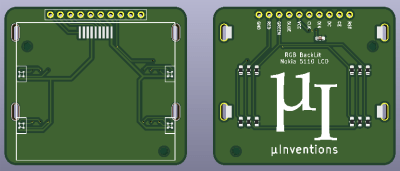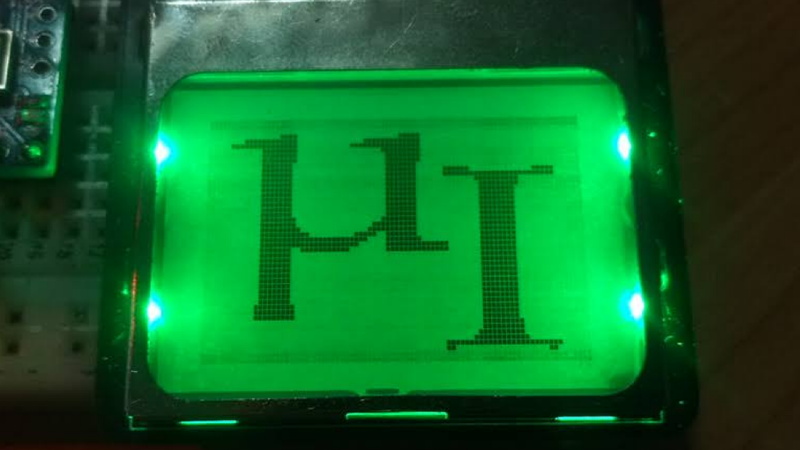Hardware hackers love the Nokia 5110 LCD. Or at least, they love the clones of it. You can pick up one of these panels for a couple bucks wherever electronic bits and bobs are sold, and integrating it into your project is a snap thanks to all the code and documentation floating around out there. But while it might be cheap and reliable, it’s not a terribly exciting component.
Which is perhaps why [Miguel Reis] thought he’d spruce it up a bit with an RGB backlight. While we’ll admit that this hack is mostly about looking cool, it’s not entirely without practical application. If your gadget experiences some kind of fault, having it flash the LCD bright red is sure to get somebody’s attention from across the room.
 The board itself is very straightforward, with four MHPA1010RGBDT RGB LEDs and a couple of passives to keep them happy. The Nokia 5110 LCD module just pops right on, and beyond the extra pins added for the three LED colors, gets wired up the same as before. The backlight LEDs just need a few spare GPIO pins on your microcontroller to drive them, and away you go.
The board itself is very straightforward, with four MHPA1010RGBDT RGB LEDs and a couple of passives to keep them happy. The Nokia 5110 LCD module just pops right on, and beyond the extra pins added for the three LED colors, gets wired up the same as before. The backlight LEDs just need a few spare GPIO pins on your microcontroller to drive them, and away you go.
[Miguel] is currently selling his RGB version of this iconic LCD on Tindie for only a couple dollars more than the standard version, so it looks like a pretty cheap way to add a little bling to your next project. (Tindie is owned by Supplyframe, which also owns Hackaday. But they didn’t put us up to adding this link.)
















That’s actually really useful. Two thoughts: used in a test jig to give the background color, as the author mentioned, plus an error code or friendly icon for the technician – or used in a DIY gaming handheld to add extra oomph; and possibly “strobing” the RGB LEDs plus the LCD for a poor man’s PoV implementation. Not sure if the 5110 LCD is nearly quick enough though.
Hey Im the creator of this board. There is an example of the POV implementation in the documentation here https://docs.microinventions.net/designs/rgb-backlit-nokia-5110-lcd/final-notes
The generic 5110 LCD from China isn’t quick enough for anything above 10FPS. It gets blurry above that.
I saw this a few days ago on r/Electronics, can’t believe the user got banned for posting this cool project? Especially now that they’re a Hackaday feature! Love this project!
I’m currently adding RGB backlights to a bunch of graphic LCDs, including a few nokia ones (like the 5110)..sad but a hobby is a hobby!. I’ve opted for side-viewng LED’s like the ones in the phone, I’m not sure why so many opt for standard LEDs that don’t shine into the lightpipe at the back. Sure you still get hotspots, but they are way less harsh than relying on the side spill of light to enter the backlight.
That’s really cool. Out of curiosity…I suppose you can also dim the light?
Of course, just three channel PWM provided by an 8-pin PIC that can be controlled by a serial line (a single IO, bitbanged by any host controller). The trouble with the 5110 is the backlight LED’s are too close to the display so you’ll always have hotspots. Other LCDs I used SK6812s.
When a post includes a link to a Tindie product page, please disclose that SupplyFrame owns Tindie and Hackaday, and all three benefit financially from sales on Tindie. It’s the ethical thing to do. Thank you.
Don’t stop linking! Great stuff on Tindie. Just disclose the relationship in the article, please.
I agree.
Maybe a simple (?) icon before the link whom, when hoovered, displays a message like “Tindie and Hackaday are both owned by SupplyFrame. This link is provided for your ease of use.” ?
Linking to Tindie is great when the object is cool / useful.
Fair enough.
And for fuller transparency: we (Hackaday) don’t benefit at all from sales on Tindie. Supplyframe does of course, but they also don’t ask us to run content about Tindie. They’ve been really great about leaving us to our own editorial independence, which we value probably as much as you do.
@Elliot: Thank you. I don’t detect any obvious corporate influence, but being completely transparent about possible conflicts of interest is the right thing to do.
“Tindie is owned by Supplyframe, which also owns Hackaday. But they didn’t put us up to adding this link”
Does anyone else remeber when a company used to just be that company? LOL Not a subsidiary of a subsidiary owned by some not yet heard of Conglomerate ;)
Anybody who does remember would be approaching 150 years old. The corporation, in the modern sense, with related mergers and acquisitions, has been around since the late 19th century!